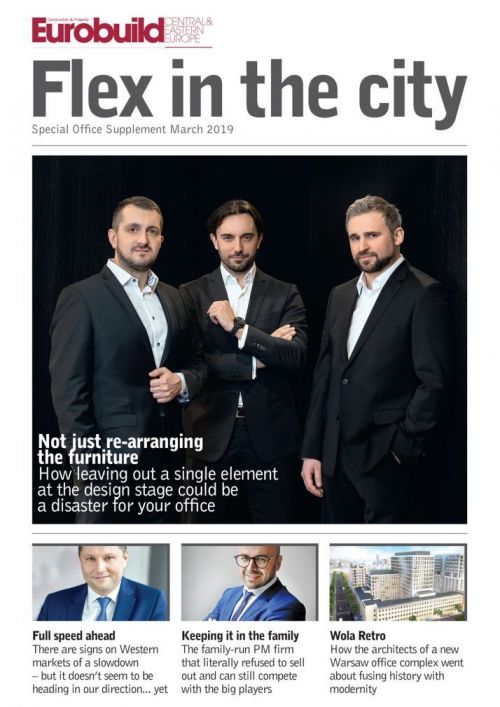Entering the flexible space race
Trends
The flexible office space sector in Europe has more than doubled since 2014, and could grow by as much as 30 pct annually over the next five years. These forecasts – based on an analysis of 20 major European markets – also include Warsaw, which dominates the Polish market for flexible space. The flexible office space sector in Europe is mainly being driven by the development of start-ups, creative industries, and small- and medium-sized companies. Furthermore, the combination of high tenant activity coupled with the business plans of the world’s largest operators means that more than 7 mln sqm could be added to Europe’s flex office market by 2023.
Western Europe leading the way
With the rise in self-employment after the global financial crisis, cities such as London, Amsterdam, Dublin, Berlin and Copenhagen have been the crucibles of the European flexible space boom. They are not merely the cities where the market has grown the most rapidly, but they have also seen the greatest number of new providers and models. Over the last three years, the amount of flexible space in Amsterdam, Berlin and London has increased by app. 25–35 pct per annum. In Amsterdam it now makes up 5.6 pct of the total office stock – the highest global concentration of flexible office space, even beating the most mature US office markets.
“The rise in the popularity of flexible office space can also be seen in other European cities. Berlin, Hamburg and Warsaw all recorded increases in the supply of flexible space over 2017 that significantly exceeded 40 pct. They are at the ‘take-off’ stage and we expect to see strong growth in the year ahead,” comments Adam Lis, the flexible office solutions manager at JLL.
The European flexible space landscape is becoming increasingly diverse with a large number of local brands operating across the market. Currently around 700 unique providers operate across the 20 largest European office markets, with 20 pct having opened their first centre within the last two years. Another source of growth have been landlord-created platforms, although local adoption varies greatly.
Diversification is key
According to JLL, by 2030 flexible office space could constitute up to 30 pct of the office markets in the cities covered in the report. At the moment, companies that use flexible office space can be divided into three groups. The first is the ‘conservative’ group. Such companies are characterised by a low percentage of flexible space in their existing portfolios, with zero or very limited expansion planned for the future. The second group includes companies that are experimenting with flexible offices. Such space accounts for a low to moderate percentage of their existing portfolios but the possibility exists for them to increase their space to 10 pct or higher over the next 3–5 years. And finally – the popularity of flexible workspace has gained the most traction with the ‘visionary’ group, which comprises companies eager to adopt flexible space, which will account for 20 pct or more of their office portfolios in the near future.
“As is the case with many relatively new sectors, the flexible space market is currently quite fragmented. At present, in large European cities there are at least 25 individual providers, but less than 15 pct of European brands operate in more than three locations. Nonetheless, they have the best chance of maintaining the flexible market’s high pace of development. Interestingly, more than half of the flexible space in Poland is in the hands of the four largest providers,” adds Adam Lis.

Mateusz Polkowski, the head of research and consulting at JLL
Flexible offices continue to boom
JLL estimates that in recent years the flexible office space market in Poland has grown by around 30–40 pct per year. Companies offering flexible office space already have more than 250,000 sqm (including signed locations that have not yet been opened). Around 75 pct of this space is in Warsaw.
“Our data confirms that in 2018, in Warsaw alone, providers of flexible office space leased 112,000 sqm, illustrating that this sector is becoming an increasingly important source of demand for offices. Furthermore, because of start-ups, small and medium-sized businesses, the creative industry and increasingly large corporations, the flex market has huge potential to grow even more. This future potential is especially evident when you take into account the new investment on the market from companies such as Regus, Spaces, WeWork, CitySpace and Business Link. Our data shows that flexible space accounted for 22 pct of the office space leased last year in central Warsaw,” comments Mateusz Polkowski, the head of research and consulting at JLL Poland.
What is the key ingredient in the success of flex office concepts? Flexible office space responds perfectly to the changing needs of employees and the evolution, or even revolution, of our working styles. Today we are increasingly seeking out creative space that is available by the hour, encourages collaboration and provides a natural source of new business contacts and daily inspiration. These expectations are met by a wide range of flexible offices, which as well as conference rooms, assigned desks and virtual offices also include access to a range of events for the local community.
A sector full of challenge and promise
Although the demand for flexible office space continues to grow, there are some obstacles standing in the way of the further adoption of this model. Commonly raised concerns include the issues of information security, confidentiality and privacy in a more open environment. Other companies are worried about the potential impact on their marketing, and especially that it could weaken their brands. But such concerns seem outweighed by the risk that companies may not have enough flexible space in their portfolios. This is due to the developments on the labour market, with many employers worrying about either keeping or attracting the most highly skilled workers.
“The challenges resulting from developments on the labour market are addressed by flexible space which is a great option for increasingly mobile young people looking for innovative space in which to work. It is worth pointing out that flex operators offer a number of additional elements. These include organising various events that contribute to building a sense of community within a given office space. This is something that an increasing number of employers look for as it allows the culture of an organisation to keep up with the times,” says Anna Bartoszewicz-Wnuk, the head of workplace advisory at JLL.
Undoubtedly, the market has reached a turning point and the rise of this sector is a structural shift that will have a lasting impact. Together with wider workplace trends, it will allow for office space to be clearly differentiated into different sub-sectors.
“The sector has moved well beyond the traditional model of co-working and has the potential to offer deeper and more integrated real estate services to larger firms on a wide geographic scale. Companies are beginning to explore the potential of flexible space as an end-to-end solution across the real estate lifecycle. Perhaps most importantly, the rapid growth of flexible space is driving real and tangible change in the wider economy,” concludes Adam Lis.






















































